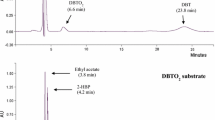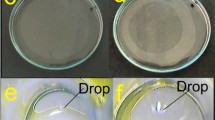Abstract
Coal carbonization by-products contain up to 10,000 aliphatic and aromatic compounds. Many of them show toxic, mutagenic, and carcinogenic character. In this study, we examined 51 pure bacterial cultures of their ability of coal tar constituent biodegradation. Bacterial cultures were isolated from both explosives and coal tar-contaminated areas. Among all of the investigated strains, 19 showed biodegradative activity. One of the isolates degraded 40% of the substrate in 14 days at a temperature of 15°C. The most active strain was identified by both classic and 16S ribosomal DNA sequencing methods and designated Rhodococcus erythropolis B10. The biodegradation of coal tar constituents, performed by identified strain, was assessed by GC/MS technique. The comparison of samples analyzed by GC/MS before and after biodegradation indicated high degradative potential of the chosen strain. It was able to degrade n-paraffins, n-olefins, benzene, alkylbenzenes, cadalene, and other PAHs, as well as recalcitrant heterocyclic compounds dibenzofuran and its methyl-substituted derivative. The B10 strain isolated and tested in this research shows promising possibilities to be used in field conditions. The biodegradation experiments indicated that satisfactory results may be obtained even in pure bacterial cultures.





Similar content being viewed by others
References
Broholm, K., & Arvin, E. (2001). Biodegradation of creosote compounds: Comparison of experiments at different scales. Groundwater Monitoring and Remediation, 101, 101–108.
De Vries, P. O., & Weytingh, K. R. (2006). Estimating soil pollution at gasworks sites. Land Contamination & Reclamation, 14, 398–402.
Dyreborg, S., Arvin, E., & Broholm, K. (1997). Biodegradation of NSO-compounds under different redox-conditions. Journal of Contaminant Hydrology, 25, 177–197.
Engwall, M. A., Grasso, J. J., & Pignatello, D. (1999). Degradation and detoxification of the wood preservatives creosote and pentachlorophenol in water by the photo-fenton reaction. Water Resources, 33, 1151–1158.
Goodfellow, M., Alderson, G., & Chun, J. (1998). Rhodococcal systematics: Problems and developments. Antonie Van Leeuwenhoek, 74, 3–20.
Holt, J. G. (1986). Bergey’s manual of systematic bacteriology, 1st ed., vol. 2. Baltimore: Williams and Wilkins.
King, M. W. G., Barker, J. F., Devlin, J. F., & Butler, B. J. (1999). Migration and natural fate of coal tar creosote plume. 2. Mass balance and biodegradation indicators. Journal of Contaminant Hydrology, 39, 249–279.
Lai, P., Zhao, H., Ye, Z., & Ni, J. (2008). Assessing the effectivenesss of treating coking effluents using anaerobic and aerobic biofilms. Process Biochemistry, 43, 229–237.
Larkin, J. L., Kulakov, L. A., & Allen, C. C. R. (2005). Biodegradation and Rhodococcus—Masters of catabolic versatility. Current Opinion in Biotechnology, 16, 282–290.
Larkin, M. A., Blackshields, G., Brown, N. P., Chenna, R., McGettigan, P. A., McWilliam, H., et al. (2007). Clustal W and Clustal X version 20. Bioinformatics, 23, 2947–2948.
Lin, X., Yang, B., Shen, J., & Du, N. (2009). Biodegradation of crude oil by an arctic psychrotrophic bacterium Pseudoalteromomas sp. P29. Current Microbiology, 59, 341–345.
Londry, K. L., & Sulflita, J. M. (1998). Toxicity effects of organosulfur compounds on anaerobic microbial metabolism. Environmental Toxicology and Chemistry, 17, 1199–1206.
Meyer, S., & Steinhart, H. (2000). Effects of heterocyclic PAHs (N, S, O) on the biodegradation of typical tar oil PAHs in a soil/compost mixture. Chemosphere, 40, 359–367.
Michaud, L., Lo Giudice, A., Saitta, M., De Domenico, M., & Bruni, V. (2004). The biodegradation efficiency on diesel oil by two psychrotrophic Antarctic marine bacteria during a two-month-long experiment. Marine Pollution Bulletin, 49, 405–409.
National Environmental Engineering Research Institute (2004) Nehru Marg Nagpur 440020 India
Padoley, K. V., Mudiliar, S. N., & Pandey, R. A. (1999). Heterocyclic nitrogenous pollutants in the environment and their treatment options—An overview. Bioresource Technology, 99, 4029–4043.
Page, R. D. M. (1996). TREEVIEW: An application to display phylogenetic trees on personal computers. Computer Applications in the Biosciences, 12, 357–358.
Pasternak, G. (2007). Mikroorganizmy degradujące związki nitroaromatyczne. Dissertation, Wrocław Univeristy of Technology
Pasternak, G., Kolwzan, B., Rybak, J., & Plaza, G. (2008). Extracellular enzymes activities as a response to biodegradation of nitroaromatic compounds. Polish Journal of Environmental Studies, 17(3A), 455–460.
Rainey, F. A., Burghart, J., Kroppenstedt, R. M., Klattic, S., & Stackebrandt, E. (1995). Phylogenetic analysis of the genera Rhodococcus and Nocardia and evidence for the evolutionary origins of the genus Nocardia from within the radiation of Rhodococcus species. Microbiology, 141, 523–528.
Ross, R. D. (1965). Industrial waste disposal. New York: Reinhold Book Corporation.
Safinowski, M., Griebler, C., & Meckenstock, R. U. (2006). Anaerobic cometabolic transformation of polycyclic and heterocyclic aromatic hydrocarbons: Evidence from laboratory and field studies. Environmental Science and Technology, 40, 4165–4173.
Sagner, A., Tiehm, A. (2008). Ecotoxicity assessment and biodegradation of heterocyclic aromatic hydrocarbons (NSO-HET) Gasworks Europe, Dresden, 1, pp. 112–118.
Saitou, N., & Nei, M. (1987). The neighbor-joining method: A new method for reconstructing phylogenetic trees. Molecular Biology and Evolution, 4, 406–425.
Seto, M., Kimbara, K., Shimura, M., Hatta, T., Fukuda, M., & Yano, K. (1995). A novel transformation of polychlorinated biphenyls by Rhodococcus sp. strain RHA1. Applied and Environmental Microbiology, 61, 3353–3358.
Siskina, W. N., & Trocenko, J. A. (1974). Svojstva novogo stamma Hyphomicrobium ispolusicego odhouglerodnyie soiedinenie. Mikrobiologij, 5, 765–770.
Snehal, R. M., Bhalchandra, K. V., Renuka, M. J., Kiran, M. D., & Sanjay, N. N. (2008). Use of response surface optimization for the production of biosurfactant from Rhodococcus spp. MTCC 2574. Bioresource Technology, 99, 7875–7880.
Suihko, M.L. (1999). European Culture Collections: Microbial diversity in safe hands. Information on holdings and services. European Culture Collections Organisation 3rd Ed, Espoo, Finland.
Tanaka, Y., Matsui, T., Konishi, J., Maruhashi, K., & Kurane, R. (2002). Biodesulfurization of benzothiophene and dibenzothiophene by a newly isolated Rhodococcus strain. Applied Microbiology and Biotechnology, 59, 325–328.
WCICoal&Steel (2007). World Coal Institute, London.
Willmusen, P. A., Johansen, J. E., Karlson, U., & Hansen, B. M. (2005). Isolation and taxonomic affiliation of N-heterocyclic aromatic hydrocarbon-transforming bacteria. Applied Microbiology and Biotechnology, 67, 420–428.
Wilson, D. C., & Stevens, C. (1981). Problems arising from the redevelopment of gas works and similar sites. Harwell, UK: United Kingdom Atomic Energy Authority AERE.
Xu, P., Yu, B., Li, L. F., Cai, F. X., & Ma, C. Q. (2006). Microbial degradation of sulfur nitrogen and oxygen heterocycles. Trends in Microbiology, 14, 398–405.
Zamfirescu, D., & Grathwohl, P. (2001). Occurrence and attenuation of specific organic compounds in the groundwater plume at a former gasworks site. Journal of Contaminant Hydrology, 53, 407–427.
Zhang, Z., Schwartz, S., Wagner, L., & Miller, W. (2000). A greedy algorithm for aligning DNA sequences. Journal of Computational Biology, 7, 203–214.
Zhu, S., Bell, P. R. F., & Greenfield, P. F. (1995). Quinoline adsorption onto combusted rundle spent shale in dilute aqueous solution at the natural pH 8. Water Resources, 29, 1396–1400.
Acknowledgments
This work was supported by polish Ministry of Science and Higher Education, grant no. NN523 425637 and partly supported by European Union within European Social Fund, Human Capital Programme. Also, we would like to thank Ms. Agnieszka Damska for her helpful linguistic advice.
Author information
Authors and Affiliations
Corresponding author
Rights and permissions
About this article
Cite this article
Pasternak, G., Rutkowski, P., Śliwka, E. et al. Broad Coal Tar Biodegradative Potential of Rhodococcus erythropolis B10 Strain Isolated from Former Gasworks Site. Water Air Soil Pollut 214, 599–608 (2011). https://doi.org/10.1007/s11270-010-0449-2
Received:
Accepted:
Published:
Issue Date:
DOI: https://doi.org/10.1007/s11270-010-0449-2




